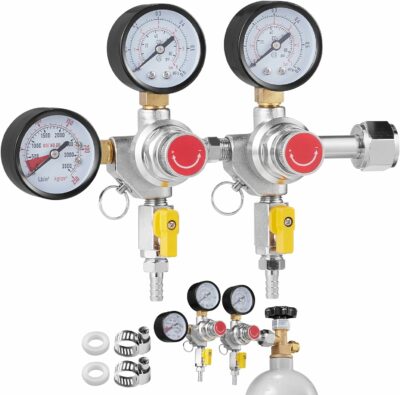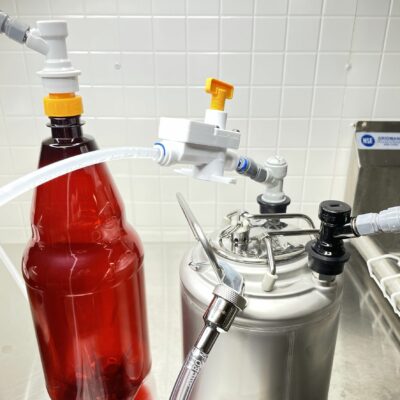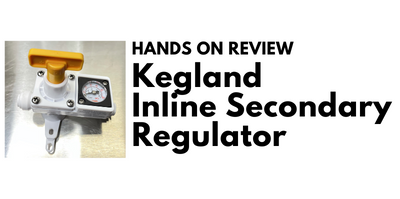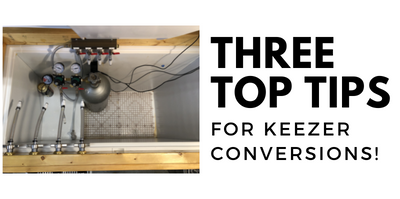
What’s the difference between Primary and Secondary CO2 Regulators?
 Pictured: VEVOR CO2 Regulator Gauge with 0-60PSI, Heavy Duty CO2 Gauge Gas System, Draft Beer Regulator with Check Valve, Adjustable Pressure Regulator for Draft Beer Homebrew (Triple Gauge Regulator) – affiliate link, note that multiple variations of this product may be available, as such a different version may appear at this link
Pictured: VEVOR CO2 Regulator Gauge with 0-60PSI, Heavy Duty CO2 Gauge Gas System, Draft Beer Regulator with Check Valve, Adjustable Pressure Regulator for Draft Beer Homebrew (Triple Gauge Regulator) – affiliate link, note that multiple variations of this product may be available, as such a different version may appear at this link
July 4, 2024
In the context of homebrewing or serving beer, a CO2 regulator hooks up to a compatible CO2 tank and steps down the pressure to carbonate and serve the beer properly. See: Balancing Your Kegerator Draft System and Diagnosing and Fixing Kegerator Foam Problems
Single Body vs Multi Body Regulators
A typical CO2 regulator provides a single output pressure. It usually has two gauges, one for the high pressure side and one for the low pressure side, although it can have a single gauge. A multi-body regulator, provides multiple output pressures and typically has one high side gauge and one gauge for each serving pressure.
Get a Regulator!
This article contains affiliate links. We may make a small percentage if you use our links to make a purchase. You won’t pay more and you’ll be supporting Homebrew Finds and more content like this. Thank you for your support!
The Benefits of Multiple Pressures
Maintaining multiple CO2 pressures in your kegerator gives you the ability to… keep kegs at different pressures. This is a requirement to maintain different carbonation levels. It’s also handy if you want to force carbonate a keg more quickly, at a higher pressure, while maintaining your standard serving pressure on a keg that’s already being served or if you want to have a utility line for purging kegs and such.
What’s the difference between a Primary and Secondary CO2 Regulator?
#1 Connection
A primary regulator is designed to connect directly to a high pressure CO2 tank. Typically via a CGA-320 fitting.
A secondary regulator is designed to connect to a primary regulator, either directly or via a manifold. Typically this is done through a barb style connection.
# 2 Pressure Rating
A primary regulator is designed to handle hundreds or thousands of PSI since it’s directly connected to a high pressure tank.
A secondary regulator is designed to handle far lower pressures. Typically 60 PSI or less.
#3 Install Cleanliness
A multi body primary regulator typically results in a cleaner install. Fewer tees, manifolds and lines to accomplish the same purpose.
#4 Regulator Response Time
This isn’t something I’ve ever read anywhere else, but based on my own experience… it’s a fact. When you’re pressurizing kegs and such using a primary regulator, the primary regulator is drawing from 100s of PSI. That means things generally happen quickly. When you’re doing the same tasks with a secondary regulator, the secondary regulator is drawing from a much lower PSI source. That means tasks take longer. It’s not a gigantic deal, but this is a clear advantage of a multi-body primary vs a primary + secondary.
Kegland Inline Secondary
An economical and flexible option for secondary regulators is Kegland’s inline secondary. That is party of Kegland’s excellent DuoTight system
- Kegland DuoTight Compatible Inline Secondary CO2 Regulator with Gauge
- via MoreBeer
- via William’s Brewing
- via Great Fermentations
- via Keg Connection
- via Amazon
- Duotight In-Line Regulator D1046 – DuoTight Compatible, No Gauge
- Inline Secondary CO2 Regulator – This is the original version, what I’d call v1. It has no gauge and is not DuoTight compatible
- In-Line Secondary CO2 Regulator D1045 – via MoreBeer
- In-Line Secondary CO2 Regulator – affiliate link, note that multiple variations of this product may be available, as such a different version may appear at this link
Get a Regulator!
More CO2 Related:
- Check Your CO2 Regulator for Leaks!
- Get a Bigger CO2 Tank… Save Time and Money!
- Using a CO2 Detector in Your Kegerator
- The Most Difficult Spot to Check for CO2 Leaks
- Build a DuoTight CO2 Gas Manifold! – for Kegland EVABarrier Tubing
- Using a Keg as a CO2 Source for Portable Serving!
- Checking for Draft System CO2 Leaks – Using The Pressure Gauge Method
- Step by Step: Finding and Fixing Keg CO2 Leaks
- Kegging CO2 Use Estimations and Calculations
- Making a Utility CO2 Line Using Luer Lock Disconnects
Also: Kegerator Tips & Gear | Keg Repair Part #s | Recent Keg Finds
Our Top Draft Resources!
Check our our Top Draft Related Resources- Commentary: Pin Lock Keg Pricing and Availability
- Check Your CO2 Regulator for Leaks!
- How to get a keg ready for first use? New Keg Cleaning and Prep
- Portable Draft Beer Serving Options!
- Pin Lock Keg Pricing and Availability
- The Most Difficult Spot to Check for CO2 Leaks
- Keg O-Ring Materials Selection! – EPDM, Silicone and Buna-N?
- Why Do I Have Bubbles in My Beer Line? Diagnosing and Fixing Kegerator Foam Problems
- Five Benefits of Using Corny Kegs As Fermenters
- Rebuilding & Reconditioning Homebrew Kegs!
- Food Safe Replacement Keg O-Rings in Bulk
- Hands on Review: Kegland DuoTight Fittings & EVABarrier Tubing!
- Why Won’t My Beer Carbonate? Fixing Draft Beer Carbonation Problems
- What Does a Flow Control Faucet Do?
- Upgrade Your Kegerator – 6 Improvements!
- Serve Homebrew on Any Kegerator & Convert Commercial Kegerator to Homebrew
- Tips and Gear for Growler Filling
- What’s the Difference Between Ball Lock Kegs and Pin Lock Kegs?
- Checking for Draft System CO2 Leaks – Using The Pressure Gauge Method
- Tip: Consider Oetiker Stepless Clamps for Kegerator Gas and Beer Lines
- Hands On Review: Inkbird ITC-308 Dual Stage Temperature Controller +WiFi Version
- Universal Poppets Tips and Tricks!
- Convert Your Mark II Keg & Carboy Washer to a Recirculating Draft Line Cleaning Pump!
- Step by Step: Finding and Fixing Keg CO2 Leaks
- Kegerator Temperature Probe Placement – To Immerse or Not To Immerse? – three tests to determine optimal pla…
- Kegerator Beer Line Temperatures & Reducing Foam with a Recirculating Fan
- Kegging CO2 Use Estimations and Calculations
- Balancing Your Kegerator Draft System
- Building a Simple Ball Lock Draft Line Flushing Setup
- Build a Recirculating Draft Line Cleaning Pump
- Home Brew Keg Roundup – New & Used, 5 and 2.5 Gallon & More!
- Damp Kegerator? Fix Kegerator Condensation
- Homebrew Temp Controller Roundup! – Kegerator and Fermentation – concepts, applications and models
- Bulk Keg Orings and Keg Parts Reference
More Homebrew Finds!
- Last 50 Finds!
- Top Deals – a curated list of the best deals
- Homebrew Reviews – one of the largest libraries of homebrew reviews in existence!
- Our Top Posts – tips, how-tos, resources posts and more
- Let’s be Friends!
Recent Deals!
10 Most Recent Homebrew Resource Posts & How-To’s!
We are Homebrew Review HQ! Our 10 Most Recent Reviews
pinnedThis post may contain affiliate links. We may make a commission when you use our links. This will never cost you extra. Thank you for supporting Homebrew Finds!
greatdealsMake sure the components you use are compatible and rated for your intended application. Contact manufacturer with questions about suitability or a specific application. Always read and follow manufacturer directions. tag:lnksfxd top:primsec tag:tpr














